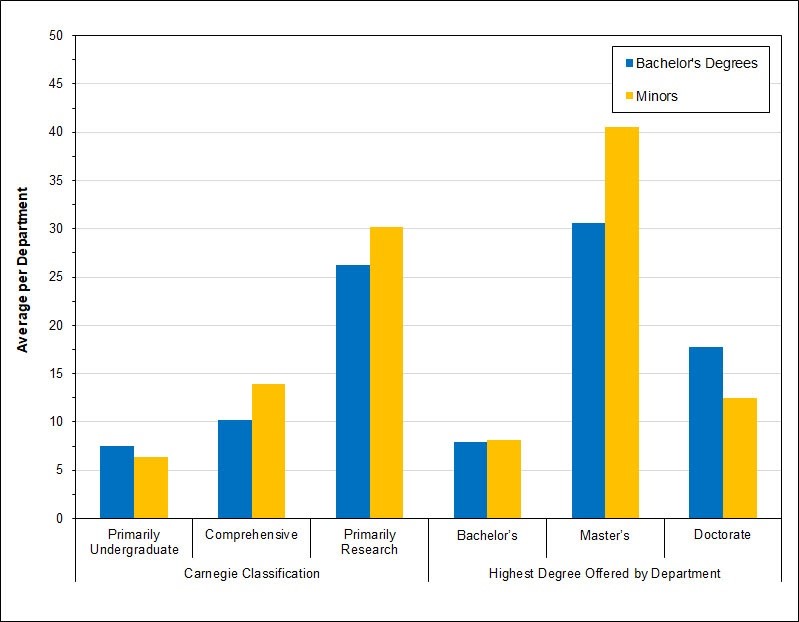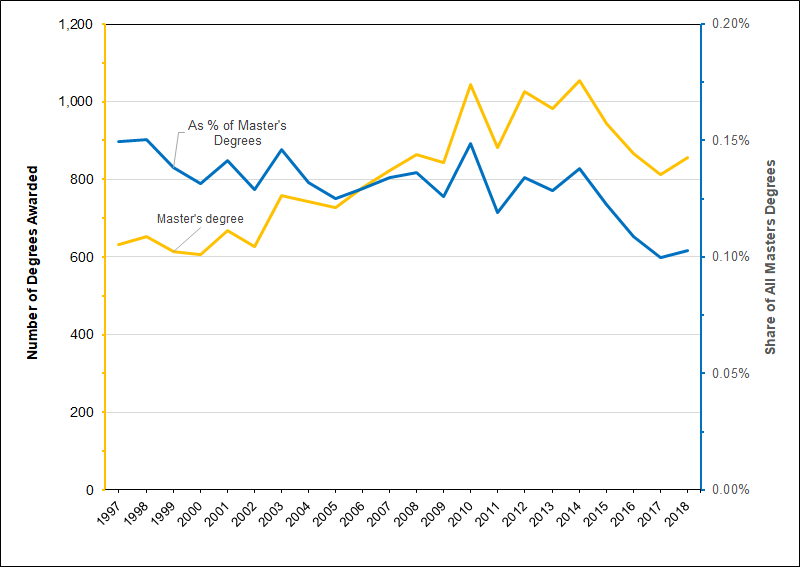A Deeper Look at Trends in Undergraduate and Graduate Religion Enrollments and Degree Completions
This article is the first in a series that will unpack and contextualize data on religion departments collected by the American Academy of Arts and Sciences Humanities Indicators project and written in collaboration between the American Academy and the AAR. Various data sources are noted along with numerous links to reports and indicators maintained by the Indicators.
As religious studies departments start to contend with the effects of the pandemic, recent studies provide critical insights into the state of the discipline on the eve of the crisis. Noting these prior shifts will be helpful to contextualize the many changes likely on the horizon, as the pandemic, directly and indirectly, alters the material conditions that surround the academic study of religion. Recent data collected by the Humanities Indicators and US Department of Education show the far-reaching impact of the 2007 recession on religious studies and the humanities more broadly. Many researchers have noted that US higher education has not sufficiently recovered from early-recession cuts and was already ill-prepared for another economic downturn. Since the recession, there have been a number of resulting or concurrent changes in state and institutional funding and student choice. We hope these data prompt reflection on a number of critical questions relating to the future of the academic study of religion.
To begin at the institutional level, an initial data point to note is that the number of institutions awarding degrees has been fairly stable in recent years. Between 1999 and 2011, the number of colleges and universities awarding at least one religion degree grew from 510 to 596. From that peak in 2011, the number declined 4% to 571 in 2017 (the most recent year with data; Fig. 1).
Fig. 1 Number of Institutions Awarding Bachelor’s, Master’s, or Doctoral Degrees in Selected Humanities Disciplines, 1999 to 2017

Source: IPEDS Completions Survey from Department of Education, tabulated using the NCSES Data Tool at https://ncsesdata.nsf.gov/ids/ipeds_c.
As many faculty know, undergraduate majors and enrollments are key indicators of health for departments and across the field. There is, of course, great variability among institutions. Instances where institutions have movement in a direction counter to national numbers are instructive as to how particular factors influence enrollments and majors. In addition to raw major counts, these figures also include a value for percent-of-all-degrees. This proportional value is critically important for interpreting contemporary trends, as it takes into account changes in overall higher education degree production.
Undergraduate Students
Degrees Conferred
It will not come as a surprise that the number of bachelor’s degrees awarded in the discipline has been trending downward in recent years, but the speed of the decline is notable. From their peak in 2013 the number of bachelor’s degrees conferred in the academic study of religion fell 31%, from 5,012 to 3,479 degrees, in just five years (Fig. 2). This was the largest decline in 28 years of available data for the discipline, and brought the number of conferred degrees down to levels last seen in the late 1990s.
Fig. 2 Degree Completions in Religion (Absolute Number and as a Percentage of All Bachelor’s Degrees), 1997–2018
Source: IPEDS Completions Survey from Department of Education, tabulated using the NCSES Data Tool at https://ncsesdata.nsf.gov/ids/ipeds_c.
This decline also occurred at a time when the overall number of undergraduate degrees was trending upward. As a result, religious studies fell from a high of about .31% of the overall number of bachelor’s degrees in the mid-2000s to a low of .17% of the degrees awarded in 2018. (Slightly more than 2 million bachelor’s degrees were conferred by U.S. institutions of higher learning that year.) This proportion was the lowest point in a downward trajectory that began in 2006, but it was still slightly higher than the levels seen from 1988 to 1997.
Undergraduate Course Enrollments
There is no similar longitudinal data on the trend in enrollments in religion departments, but the recent American Academy survey estimates that there were approximately 234,760 students enrolled in undergraduate religion classes in Fall 2017 (about 2% of all four-year students in the United States), with a median of 422 students enrolled per department. Note that the sample for religion departments was first drawn in 2007, so while it tracks change in a consistent number of departments, it captures the loss in departments—and students—since that time, but not the gains in the number of departments since that time. So the estimates understate the total number of students.
Fig. 3: Estimated Average and Median Enrollment in Undergraduate Religion Courses per Department, by Type, Fall 2017
Source: Humanities Indicators, The State of Religion Departments in Four-Year Colleges and Universities (2020), table REL5.
As noted above, the number of religion majors is declining generally; however, when we separate institutions by sector, we learn that the significant declines between 2012 and 2017 were concentrated in primarily undergraduate and primarily research institutions, and not at comprehensive institutions.
For departments that are thinking about where they stand in relation to others, the most recent department survey from the American Academy estimates that, on average, religion departments awarded 12.1 bachelor’s degrees per department in the 2016–17 academic year. Students also completed an average of 13.5 minors per department.
Relative to other humanities disciplines, Religion had an unusually high ratio of undergraduate minors to majors (Table 9a). Figure 4 shows how these ratios play out across different sectors. Among the larger disciplines, religion was second only to Languages and Literatures other than English in the ratio of bachelor’s degrees to minors (averaging slightly more than one minor completed per degree completed).
Fig. 4 Estimated Average Number of Bachelor’s Degrees and Minors Completed in Religion per Department, by Type, Fall 2017
Source: Humanities Indicators, The State of Religion Departments in Four-Year Colleges and Universities (2020), tables REL6 and REL8.
On average, the most bachelor's degrees and minors per year are conferred at research universities and by departments where the highest degree offered is at the Master’s level. 77% of the responding departments and 65% of reported enrolled students are located in institutions where the highest degree offered is at the bachelor’s level.
Graduate Students
Graduate indicators are important to consider both with respect to the health of departments and programs and for how they relate to the production of the professoriate. Across higher education, new graduate programs have proliferated and since 2000, the number of US adults with graduate degrees has doubled. Again, these facts make it important to consider not just the total number of graduate degrees in religious studies, but also the share of all such degrees, to best understand the state of the field up to 2018.
Religion departments had an average of 93.3 students enrolled in graduate-level courses per department (second only to Linguistics), but an average of 9.1 master’s or doctoral graduate students in their department (only Combined English/LLA, Folklore, and Philosophy have fewer). The difference between the average (93) and the median (24) enrolled students and disparity between total enrolled students and students in the department suggest a few very large departments might be skewing the results, and that religion departments play an outsized role in teaching students from other departments.
The academic study of religion conferred its largest number of master’s degrees on record in 2014 (1,055). After that peak, however, the number fell 19%, to 855 master's degrees awarded in 2018. With that decline, the share of all master’s degrees awarded by religion departments also fell, from .14% in 2014 to .10% in 2018. While modest, relative to the change noted above in bachelor’s degrees, this represents the lowest share in records extending back to 1987.
Fig. 5 Master’s Degree Completions in Religion (Absolute Number and as a Percentage of All Masters Degrees), 1997–2018
Source: IPEDS Completions Survey from Department of Education, tabulated using the NCSES Data Tool at https://ncsesdata.nsf.gov/ids/ipeds_c.
At the doctoral level, the annual number of religion PhDs has been trending upward in recent years (aside from an anomalous spike 2002)—rising from an average of 230 degrees from 1997 to 2007 to an average of 258 since 2008 (and over 270 degrees in three of the four most recent years; Fig 6).
Fig. 6: Doctoral Degree Completions in Religion (Absolute Number and as a Percentage of All Doctoral Degrees), 1997–2018
Source: IPEDS Completions Survey from Department of Education, tabulated using the NCSES Data Tool at https://ncsesdata.nsf.gov/ids/ipeds_c.
Similar to the findings at the other degree levels, the growth in the number of doctoral degrees in religion did not keep pace with the general growth in the number of PhDs. The discipline’s share of all doctorates dropped from around 0.5% in the late 1990s and early 2000s to 0.35% in 2018.
Despite budgetary restraints and declines in majors, religious studies departments—on average—have remained stable, and the number of institutions offering religious studies degrees continues to rise. The national trends of declining student interest in religion degrees, and the humanities more broadly, cannot be separated from the current discourse on the value and purpose of college education. These indicators point to the need for careful consideration and engaged response by faculty, administrators, and advocates for the academic study of religion. Across higher education, the impact of the pandemic will be unprecedented and follow after already-concerning downward shifts in humanities degree completions. Religion scholars can and should use these data to act with urgency to inform their strategic response to the coming challenges, and they should ally with other humanists to counter the rhetorical devaluing of particular fields of study and waning institutional support.






